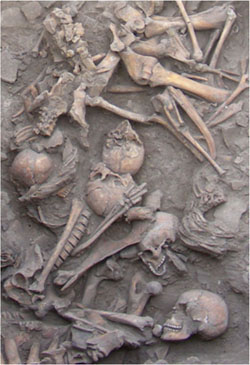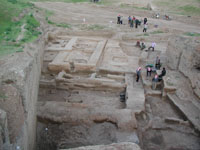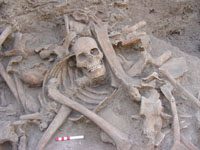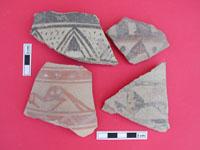Current Research
Early Warfare

Tell Brak mass grave

Tell Brak mass grave
The most startling and important find at Tell Brak has been the discovery of a series of mass graves at the outlying mound of Tell Majnuna, one of the 'corona' of sub-mounds at the edge of Brak's Outer Town. Four mass graves were found, each consisting of a dense layer of mostly-disarticulated human bones belonging to individuals mainly between c 20 and 45 years of age. The conservative estimate of minimum number of individuals recovered thus far in each grave ranges from 14 to over 100, with the actual count in each case much greater, as only parts of each grave were excavated. One grave was covered by a layer of broken ceramic plates and animal bones, suggesting that a post-deposition feast had taken place. The debris in and around the graves contained stamp-impressed clay container sealings and ceramic types datable to the LC 2-3 Period, c 3900-3600 BC, contemporary with urban growth and increased internal complexity.
The age curve, mostly young adults (no children or elderly), makes it unlikely that the cause of death was either natural or from catastrophic disease. We reconstruct that the mass graves are the result of organized violent conflict, or warfare. The consistent degree of disarticulation suggests simultaneous death of all individuals, while small bone loss and carnivore damage indicate that the skeletons lay exposed on the battlefield for some time before being haphazardly gathered for reburial. The stratigraphic context affirms simultaneous burial.
The scale of Brak was such that an external attack seems unlikely. Meanwhile, their contemporaneity with Brak's urban expansion is suggestive that the conflict was the result of internal social stresses associated with population aggregation, increasing economic disparity, and political disenfranchisement. Thus this may be the world’s first evidence for civil war.
The graves were placed at the settlement edge and within a vast pile of rubbish, reflecting additional logistic challenges associated with early urban living. Many modern challenges to urban sustainability –clean water, housing, rubbish removal–were already faced by the world’s earliest cities.




